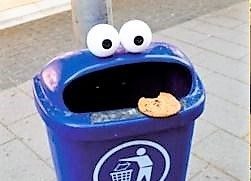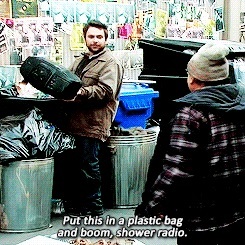IoT – Internet of Trash?!

The City of Brotherly Love introduces the IoT to Trash and it may just be a match made in heaven…
Digitalization is transforming the way cities operate, from IoT solutions for parking, crime fighting, and road maintenance, more and more cities aspire to add “smart” to their title. One aspect of this growing trend is quite literally – garbage, and the city of Philadelphia is leading the charge in becoming a smart-garbage city.
Garbage is a problem and one that just keeps piling up. 230 million tons of “trash” are generated in the US yearly, 4.6 pounds per person per day[1] and since 2009, Philadelphia has begun experimenting with smart waste solutions to tackle this problem. It began with the purchase of 200 Bigbelly trash bins, by 2015 there were over a thousand spread throughout the city.
Bigbelly, a Massachusetts based company, claims to be “transforming waste management practices and contributing to the Smart Cities of tomorrow.”[2] They do so with trash bins that via a compression mechanism can contain 5-8 times more trash than a normal street bin. But that’s not all, these bins contain a chip that connected them to the internet and enables them to wirelessly communicate with a centralized data-base. Using an internal sensor and this connectivity, the bins alert the city’s waste management personnel when a bin is full and needs to be emptied.
What benefits does Philly see from this endeavor? For starters, emptying trash comes with costs that include labor, fuel and vehicles. In Philadelphia, the use of Bigbelly has reduced trash collections from 17 to three times per week, saving the city $1 million in operational, fuel and truck costs.[3] Reducing the amount of trash and increasing recycled trash also has a monetary value, the city of Philadelphia gets $50 per ton from recycling and avoids $63 per ton for landfill tipping fees.[4]
Not all benefits can be assigned a direct value, the environment and sustainability of cities are also big winners from this initiative. Municipal solid waste landfills are the second-largest source of human-related methane emissions in the United States and Bigbelly is combatting this by increasing the percentage of trash recycled[5]. Open trash bins in cities also tend to attract vermin, for most people an uninvited guest on the city streets, with potential health repercussions. Finally, there is an aesthetic advantage, as the bins keep streets and parks clean from overflowing trash.
Not everything is rosy in the smart-trash industry. a smarter system requires operational adjustments in the municipal waste management department and some have been lagging. Philly waste collection crews were initially not trained to operate the new bins and often lacked the require d tools.[6] Another recurring problem is collection crews doing their regular runs as they either ignore or do not receive information regarding the state of the Bigbellys.[7] An additional operational aspect that was overlooked is the extra time it takes to empty Bigbellys compared to the old-style bins.
d tools.[6] Another recurring problem is collection crews doing their regular runs as they either ignore or do not receive information regarding the state of the Bigbellys.[7] An additional operational aspect that was overlooked is the extra time it takes to empty Bigbellys compared to the old-style bins.
Despite not everything going smoothly, Bigbelly and the smart waste market is continuing to expand, with an expected annual growth rate of almost 17% in the next three years.[8] With smart bins potentially installed in every street corner of major metropolitan areas, what other trash solutions can they provide? One potential area to explore is smart trash sorting capabilities. Perhaps the smart-bins of the future will be able to sort the trash into different bins based on the recycling potential. With the use of bar-code reading and RF ID tags this may very well be the next step in increasing recycling levels from the current 25% in the U.S.[9] Taken a step further, bins could potentially identify items to the brand level and the aggregated data could reveal which consumer goods are producing more trash than others. Furthermore, municipalities could identify areas and streets that are high trash producers and provide targeted recycling solutions to them.
Finally, one may look beyond the trash that these machines were originally designed to handle. As Leila Dillon, Bigbelly’s vice president of global marketing, puts it “We are a smart solar-powered, connected technology platform that is literally sitting in the streets of New York”[10]. Indeed, in the Big Apple, Bigbelly is hoping to turn the bins into wireless hotspots. Providing street level Wifi is just one option, in the future these devices could measure foot traffic, pollution levels and the weather to name just a few potential ideas. Thinking of these smart-bins as a platform on which one may design various applications, garbage may very well play a major role in the cities of the future.
[1] Melissa Jun Rowley, “How the Internet of Things is Aiding the Garbage Crisis”, Cisco’s Technology News-site, April 18th 2016, https://newsroom.cisco.com/feature-content?articleId=1757267, Accessed November 2016
[2] David Stephenson, “Incredible example of rethinking “things” with the Internet of Thins”, Stephenson Blog on Internet of Things, June 1st 2015, http://bigbelly.com/incredible-example-of-rethinking-things-with-internet-of-things/, Accessed, November 2016
[3] “These 4 Major Cities Are Using Sweet New Technology To Become Smarter and Greener”, Huffington Post, September 17th 2015, http://bigbelly.com/these-4-major-cities-are-using-sweet-new-technology-to-become-smarter-and-greener/, Accessed November 2016
[4] David Stephenson, “Incredible example of rethinking “things” with the Internet of Thins”, Stephenson Blog on Internet of Things, June 1st 2015, http://bigbelly.com/incredible-example-of-rethinking-things-with-internet-of-things/, Accessed, November 2016
[5] “How Much Do we Waster Daily?”, Duke University Center for Sustainability & Commerce, https://center.sustainability.duke.edu/resources/green-facts-consumers/how-much-do-we-waste-daily, Accessed November 2016
[6] Michelle Breidenbach, Syracuse.com, July 24th 2013, http://www.syracuse.com/news/index.ssf/2013/07/phillys_4000_big_belly_trash_cans_a_messy_waste_city_controller_says.html, Accessed November 2016
[7] Ibis
[8] Erika Morphy, Computerworld, May 28th 2105, http://www.computerworld.com/article/2927464/internet/a-pilot-project-in-new-york-could-lead-to-cities-finally-implementing-municipal-wi-fi.html, Accessed November 2016
[9] Lee Goldberg, “Sorting Out Smart Cash”, EE Times, November 4th 2012, http://www.eetimes.com/document.asp?doc_id=1149542, Accessed November 2016
[10] Linda Poon, “New York City is Turning Smart Garbage Bins into Free Wi-Fi Hotspots”, The Atlantic – City-Lab, July 10th 2015, http://www.citylab.com/navigator/2015/07/new-york-city-wi-fi-trash-cans/398258/, Accessed November 2016



This is such a fascinating example of digital transformation. Taking an everyday, antiquated system such as waste management and revolutionizing it for the digital age will have an invaluable impact. I really loved some of the recommendations Amit proposed for how Bigbelly can take “smart trash” further. Two in particular are: 1) leveraging data collection to track consumer patterns; and 2) using these bins as potential hotspots to make a city even more connected.
To this first point on leveraging data. I see so many opportunities here. Not only better understanding pedestrian foot traffic and on-street behaviors, but also the value we could glean from assessing the types/brands of trash people discard. Through either RFID or NFC tagging, we would suddenly have insight into how and what people are consuming in different parts of the US (or even the world). Bigbelly could even consider selling this data to retailers to help them better understand customer behavior and usage patterns in specific geographic regions. This information would be invaluable for targeted marketing, helping brands better capture value from their captive market audience, while also supplementing BigBelly’s value capture.
Secondly, the dual role these smart bins could play as wifi hubs really resonated with me. Living in San Francisco — a city that has notoriously struggled with implementing city-wide wifi — there has always been a promise of an Internet-connected city that has yet to materialize.[1] This technology would provide visual cues to pedestrians as to where the hotspots are, while also serving the transactional purpose of getting more garbage off the ground and to the right place.
Thank you for surfacing this technology, Amit – so interesting!
[1] http://www.sfexaminer.com/sf-begins-crunching-numbers-citywide-internet-access/
Hello Ameg,
Excellent post and choice of topic: improving the way we manage our waste (and we recycle it) will definitely be a critical element of our quest for sustainability in the near future.
I really like your suggestion to push the concept of smart bin further. Identifying how to recycle different materials, in particular, seems to be a big issue: about 20% of recycled material is actually contaminated, that is, it contains non-recyclable material [1].
A French startup, Uzer [2], has started to tackle the issue by inventing a bin that identify the most suitable recycling bin for each item. The user simply needs to scan the item’s barcode on the bin’s barcode reader; the bin then leverages a comprehensive online database to retrieve information about the packaging material used for that particular item, and suggests to the user the most suitable recycling bin. What is more, a purpose-built app allows the user to run some useful statistics about his/her consumption and recycling habit to help reduce his/her environmental footprint. This is genius!
Yet, however smart a bin can be, nothing will be more effective than changing the people’s consumption habits. With waste generation expected to treble by 2100 [3], we simply cannot continue with the current practices based on disposable packaging and fast changing trends. An alternative model is possible, and might just require us to look to our past: our grandparents, for instance, would have considered completely normal to bring their own containers to a store, and some stores are starting to go packaging-free again [4]. Smart solutions don’t always need to be high-tech!
[1] http://www.telegraph.co.uk/news/earth/earthnews/9757081/Up-to-a-fifth-of-recycling-contaminated.html
[2] http://www.uzer.eu/eugene-poubelle-english/
[3] http://www.nature.com/news/environment-waste-production-must-peak-this-century-1.14032
[4] http://www.thekitchn.com/americas-first-packagingfree-g-150008
The BigBelly bins have been a great addition to waste management technology. I really appreciate that you pointed out the added difficulty of emptying these bins. Implementation of these new trash bins certainly requires some behavior change by waste management staff in each of the cities. Perhaps BigBelly is also working to make disposing of BigBelly waste simpler. Do you think the waste management group in Philadelphia will be able to change their operations and leverage the digital technology to actually streamline operations? It probably makes sense to have the trash bins alert waste management when they are at a certain threshold. This way, they are not sporadically picking up trash all around the city.
I agree with Roberto, and think that waste management technology will only get us so far. People must fundamentally change their consumption habits to get to the root cause of this issue. I think the first step for consumer understanding is to SHOW people where their trash actually ends up. MIT ran a project called trash track to see where their trash components actually ended up after a few days, weeks and months. It’s so easy for people to throw out their trash and forget about it. Showing people the reality of the situation is likely imperative to actually solving the issues. Deploying a trash tracker for every single piece of trash would be extremely costly, but perhaps it would make sense to track a select group of trash and connect it to an app for people to understand the implications of their waste habits.
Check out this video to see MIT’s project in action! http://senseable.mit.edu/trashtrack/
Wow! Smart Cities seem so tangible after reading this article 🙂 I love this idea and I can’t wait to see this initiative propagate across the country/world! The idea of combining it with other civic goods and services (like street wifi) seems just one of many possible dual purposes. I hope that the company continues to investigate partnerships and commits to R&D. I see a great future if the company continues to stay one step ahead when it comes to Smart City value propositions. They should definitely try to leverage the data they can collect and move into other smart ways of managing waste. I’m excited to see where this company goes!